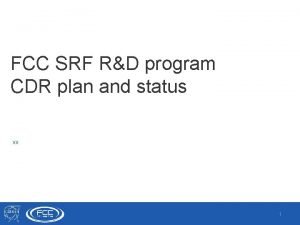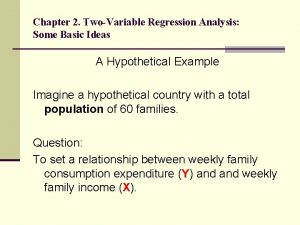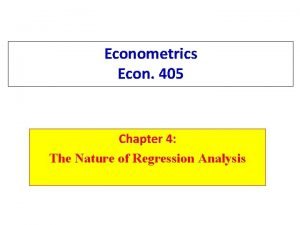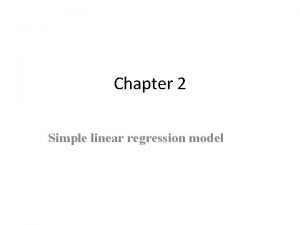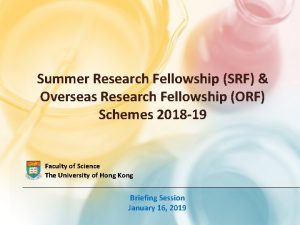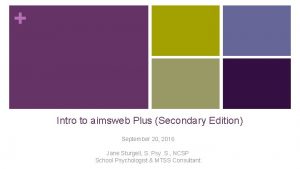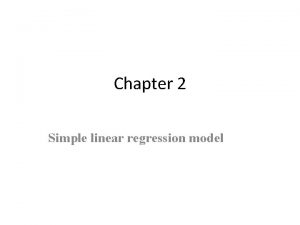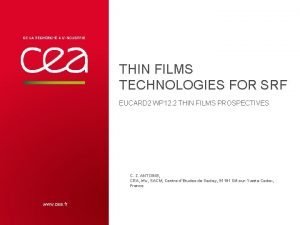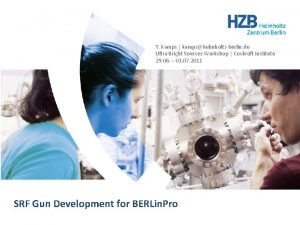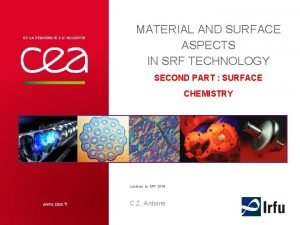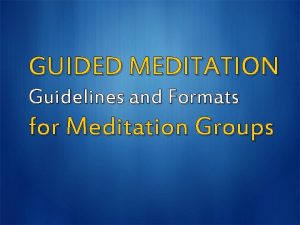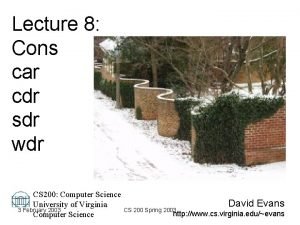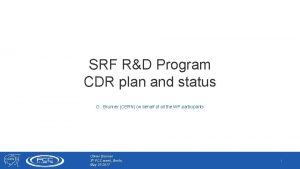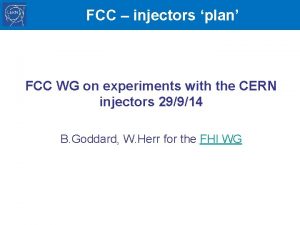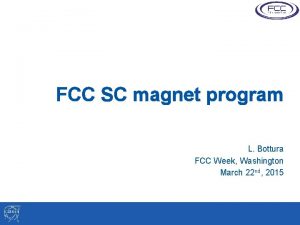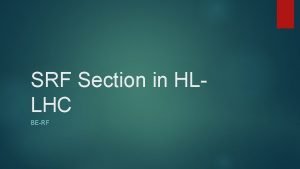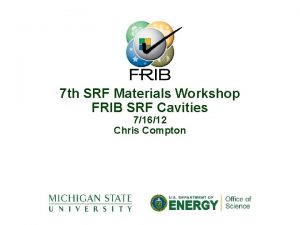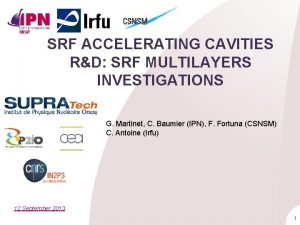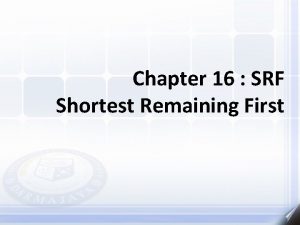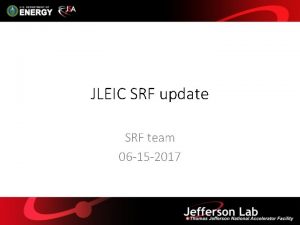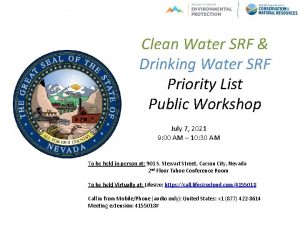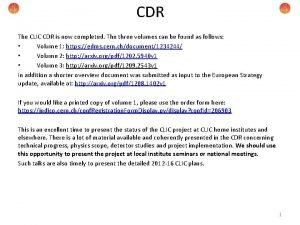FCC SRF RD program CDR plan and status











- Slides: 11

FCC SRF R&D program CDR plan and status xx 1

Introduction 9 work packages : • • • RF scenarios and parameter layout Cavity design and beam - cavity interaction Cavity material & performance CERN-LNL-STFC Collaboration agreement on cavity material & fabrication Cavity fabrication Cryomodule challenges High efficiency power sources Fundamental power couplers Low impedance deflecting cavities Scope : • Define “ideal” RF system for each machine • Propose optimum compromise vs operation and installation timeline Z W H t FCChh 2

Low impedance deflecting cavities 1. Introduction 2. Development of low impedance devices is crucial for FCC_hh a. b. c. Design and simulation Fabrication is ongoing Nb coating system is under development • Status and Deliverables: • Publications? • CDR report • Device built and test report 3

Fundamental power couplers 1. Introduction a. Initiative for a coordinated worldwide effort on FPC 2. FCC specific requirements a. b. c. • Road towards high(er) CW power (1 MW? ) Need for “adaptable” couplers (i. e. “fixed”, but adaptable to different Qext without breaking cavity vacuum) Large series production: ≈ several hundreds for FCC_ee high energy and booster Status and Deliverables: • • Description of challenges, perspectives and limits (CDR report) R&D roadmap 4

High efficiency power sources 1. Introduction a. b. Big machine - > efficiency plot (Erk, Rome 2016) Each % - > xx MW -> XX MCHF 2. Revolution against the “textbooks”: a. b. HEIKA-phase 1 HEIKA-phase 2 3. Very high efficient FCC klystron demonstrator: a. b. Parameters and design Mechanical design and fabrication (Thales) • External collaborators/contributors: • ULAN (collaboration agreement) • HEIKA • THALES • Status and Deliverables: • • Description of challenges, perspectives and limits (CDR report) Roadmap towards demonstrator fabrication 5

Cryomodule challenges 1. Introduction a. FCC CM design will be based of existing 2 or 4. 5 K design (ESS, LEP, LHC, XFEL) 2. Specific topics of interest a. b. Multi-purpose cryomodules CM cost model • External collaborators/contributors: • Preliminary discussions with JLAB and CEA Saclay • Interesting developments at JLAB and possibly BNL and KEK • Status and Deliverables: • Description of FCC specific requirements (CDR report) 6

Innovative cavity fabrication techniques 1. Introduction a. FCC_ee installation and operation timeline pushes for rapid and cost effective cavity fabrication techniques i. Ex: W -> H machines, hundred of cavities to be built assembled tested and installed 2. Technology developments a. High velocity hydroforming: i. b. Determine forming limits of high-velocity Electro-Hydraulic Forming (EHF) for Cu structures as substrate for superconducting coating (and for bulk superconducting Nb) Spinning: i. Efforts towards seamless cavity fabrication (LNL) • External collaborators/contributors: • LNL • STFC • BMAX • Status and Deliverables: • • LNL 400, 800 MHz cavities (on hold) LNL 6 GHz cavities + characterisation at STFC (ongoing? ) Bmax ? CDR report 7

Cavity material & performance 1. Introduction a. Technology choices and limits i. Sarah’s Paper (ref. . ) 2. R&D and perspectives a. Bulk Nb: i. Performance and limits (reference to ESS, XFEL, …) ii. b. N_doping: (FNAL collaboration) Nb/Cu: i. CERN developments ongoing (Uni Geneva, . . ) ii. CERN-LNL-STFC collaboration iii. ECR: JLAB c. A 15: i. Nb 3 Sn on Nb (FNAL) ii. Nb 3 Sn on Cu (CERN) iii. V 3 Si (CERN) • External collaborators/contributors: • • • LNL STFC Uni Geneva FNAL JLAB • Deliverables: insert list of publications 8

RF scenarios and parameter layout Skeleton: 1. Introduction 2. Model description 3. Machine layout (optimization for each machine): a. b. 4. Limiting factors Design choices and alternatives Staging scenarios: a. b. Timeline: installation and operation Optimized scenario and options Cost and study model 6. Sensitivity study 5. • Deliverables: • FCC note in preparation (full model) • FCC note in preparation (scenarios and layout) • Example: • Here insert an example 9

Cavity design and beam - cavity interaction (1) 1. Introduction 2. Cavity challenges: a. High energy: aim at acceleration efficiency i. ii. b. Number of cells Material, frequency, temperature High intensity: i. ii. optimize cell shape with regard to HOMs HOM damping schemes 3. Beam dynamic challenges: a. b. Single bunch instabilities (Juan’s analysis, report in preparation) Multi-bunch instabilities: i. ii. Extension of the simulation tool for Gaussian bunch and synchrotron damping (BLOND) – done by Juan Study of coupled bunch instabilities for all machine using the improved code – to be done, Ivan) 4. HOM heating for all machine – in progress, Ivan 5. Impedance budget limits (narrow and broad band) a. Resonant build-up - in progress/done, Juan/Ivan 6. Analysis of the need for a RF harmonic system – to be done? 7. LLRF: a. b. FCC_hh: 25 ns - >LHC, 5 ns option -> transverse emittance preservation (FCC STP) FCC_ee: scenario for high intensity operation (see Ph. Baudrenghien, FCC week 2016) • External collaborators/contributors: • Rostock University (FCC_ee high energy) • Frankfurt University (FCC_hh HOM damping) 10

